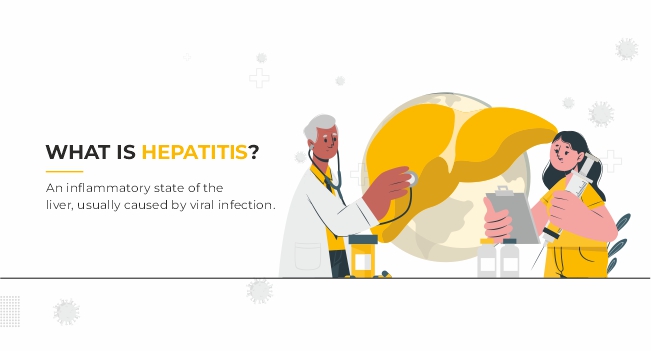
Every year on July 28, the world observes World Hepatitis Day. This year, Can’t Wait is the theme and focuses on accelerating the fight against viral hepatitis and the importance of timely testing and treatment.
Hepatitis impacts more than 354 million of the global population. In addition, the world is facing a new outbreak of unexplained acute hepatitis infection that affects children.
Before we get into the A,B, C of hepatitis, here are global statistics on the prevalence of this viral infection.
- Roughly 4% of the world’s population (around 325 million people) live with viral hepatitis.
- The disease causes 1.34 million deaths yearly.
- WHO estimates that 296 million people live with chronic hepatitis B infection in 2019.
- 1.5 million new infections are reported each year.
- In 2019, hepatitis B resulted in an estimated 820 000 deaths, mostly from cirrhosis and hepatocellular carcinoma.
What is Viral Hepatitis?
Viral Hepatitis is an infection of the liver that causes inflammation and liver damage.
Five different types of viruses cause hepatitis: A, B, C, D, and E. Hepatitis A and E usually cause acute or short-term infections which do not lead to chronic complications, whereas hepatitis B, C, and D can cause chronic or long-term complications like cirrhosis of the liver, liver failure, fibrosis, and liver cancer.
Cytomegalovirus, Epstein - Barr virus, Herpes Simplex virus can also cause Hepatitis. High serum transaminase levels in the liver function tests can also signify hepatitis.

Early diagnosis and treatment can help prevent the complications associated and reduce mortality caused due to hepatitis.

Hepatitis infections are usually asymptomatic. The symptoms can show up later when there is any chronic infection.
Hepatitis A
Hepatitis occurs through the fecal-oral route of transmission. This infection does not cause long-term complications and chronic illnesses. The presence of anti - HAV antibodies indicates the presence of infection. The diet should include nutritious food and plenty of fluids. Avoid alcohol for a couple of months after recovery.
Prevention
- Hepatitis A Vaccine
- Improvement in hygiene and sanitation
Hepatitis-B
Hepatitis B is one of the leading causes of chronic liver disease and liver cancer. The infection is usually asymptomatic, but symptoms can last for a few weeks and subside without causing long-term complications or chronic infections.
Sources of infection
The hepatitis B virus spreads through contact with an infected person’s blood, semen, or other body fluids.
- Sharing of needles or injections
- Sexual transmission
- Contact with blood or open wounds of an infected person
- Vertical transmission from mother to child
HBsAg levels mark the presence of Hepatitis B and help in understanding the stage and progress of the infection. Persistence of the infection over six months is considered chronic hepatitis infection.
The treatment is usually monitoring and preventing acute liver failure. Anti-virals are also given to treat acute viral infections and those at risk of liver injury.
Prevention
- Hepatitis B vaccine containing HBsAg can provide active immunization against the virus.
- Hepatitis B immune globulin is used to prevent Hepatitis B and to treat acute exposure to HBsAg.
- Practice safe sex and avoid sharing needles.
Find out how healthy your liver is with Liver Function Test
Hepatitis C
Acute symptomatic infection from Hepatitis C is rare. They are usually asymptomatic and are identified after cirrhosis of the liver sets in. Abnormal Liver Function Tests can help in identifying Hepatitis C. The presence of Anti-HCV RNA in the blood gives the diagnosis of Hepatitis C. The source of infection is similar to hepatitis B infection. Hepatitis C is treated with Anti- Viral therapy.
Hepatitis D
Hepatitis D occurs in those already infected with hepatitis B or can co-occur with hepatitis B. Hepatitis D virus requires the hepatitis B virus to exist. Anti-HDV antibodies in the blood indicate the presence of Hepatitis D. The source of infection and the management of the hepatitis D infection are similar to the Hepatitis B infection.
Hepatitis E
Hepatitis E is spread through the fecal-oral route of transmission with the infected person, similar to the hepatitis A infection.
Prevention of Hepatitis
Liver function tests help understand the liver damage caused by viral hepatitis. While hepatitis contributes to liver cirrhosis and liver cancer, genetic predisposition and other factors also aggravate the risk of developing liver diseases. Knowing factors can help reduce the risk of liver injury through active lifestyle modifications and regular screenings. There is a need to increase and promote screening for viral hepatitis to prevent mortality through early diagnosis and treatment.
Mapmygenome’s scientifically curated blood tests, including major tests like Liver Function Tests (LFT), will help you in the early prevention of conditions like hepatitis. In addition, genetic counselors can be a valuable resource to families and physicians in facilitating the diagnosis and management of hepatitis.
Click here to get your Comprehensive Health Package or Call Us at 1800-102-4595 or WhatsApp at 86883 10052.
Reference-
https://www.cidrap.umn.edu/news-perspective/2017/04/who-viral-hepatitis-deaths-increasing
https://www.worldhepatitisday.org/#2022--theme:-hepatitis-can't-wait-
https://www.niddk.nih.gov/health-information/liver-disease/viral-hepatitis
https://www.ncbi.nlm.nih.gov/books/NBK554549/

